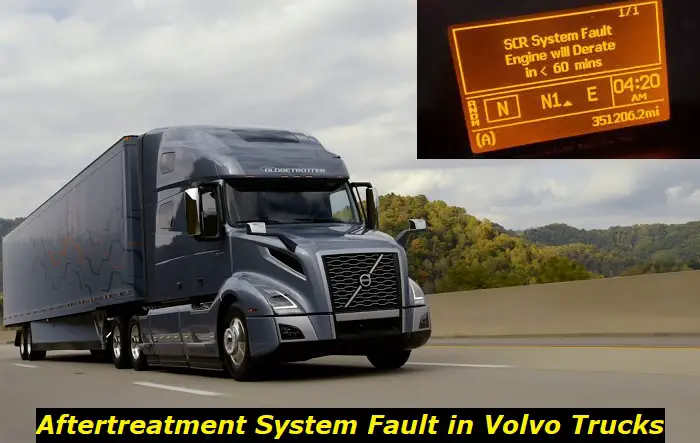Aftertreatment System Fault in Volvo – What’s Wrong and How to Fix?
Volvo is a trendsetter in the semi-trailer sector and anything next-gen auto technology. Among the numerous things you will learn and love about Volvo is the aftertreatment system. Volvo intensely invests in R&D, marketing, giving the customer the right product, and making the environment safer for all. This is why we are talking about the Volvo aftertreatment system today.
In this article, we explore the aftertreatment system that is found in Volvo diesel engines. But like every other system, the aftertreatment from Volvo is prone to issues. We investigate the aftertreatment system fault found in the Volvo vehicles and look into what usually causes this problem. To get a firm grip on the issues, we will also explore how one can fix this fault.

Aftertreatment system
The aftertreatment system can be defined as a device or a method through which heavy commercial vehicle makers install to reduce harmful exhaust emissions. The system is ideal for internal combustion engines. This reduction of harmful exhaust gases means the engine or your diesel vehicle adheres to the EPA regulations and other relevant laws.
The introduction of an aftertreatment system in vehicles meant that engines could only use low sulfur level fuel of 15 ppm or less. This comes with its unique issues in that the fuel you use in your vehicle lacks lubricity capabilities. But that's a topic for another day.
Different manufacturers of aftertreatment systems include a varying number of components. In the case of the Volvo Stage V exhaust aftertreatment system, you will find five components, namely;
- Diesel oxidation catalyst (DOC)
- Diesel particulate filter (DPF)
- Diesel exhaust fluid (DEF)
- Selective catalytic reduction (SCR)
- Ammonia slip catalyst (ASC)
All these components are found in one unit. It is for this reason, Volvo named this unit the one-box aftertreatment system. This system boasts of a smaller size that cuts weight by as much as 17 pounds. According to Volvo, this aftertreatment gives improved thermal encasing of the exhaust energy and improves the muffler's efficiency.
In the first chamber of the Volvo one-box aftertreatment system, compounds such as oxygen, hydrocarbons, nitrogen monoxide, soot, and carbon monoxide enter. All these compounds are oxidized, and you are left with carbon dioxide, water, and nitrogen dioxide. DEF is added along the way, and you end up with ammonia, nitrogen, and water.
What does aftertreatment system fault mean in Volvo?
The Volvo aftertreatment system is without issues. Many Volvo truck owners have come forward with a number of complaints regarding this exhaust component. There are around 40 trouble codes that the aftermarket control module (ACM) can record, all of which relate to the aftertreatment system.
The ACM is in direct communication with the Engine Control Module (ECM). When an error is detected, a check engine light will appear, or a warning message will pop up on the dash. In some instances, the check engine light and an additional warning light or message can appear together.
When the aftertreatment control module reports a fault, it is usually because a part of the aftermarket system has failed or malfunctioned. Let us look at the possible causes of these problems and how best one can solve them;
1) Nitrogen oxide limits exceeded
This is a problem all too familiar for those who own the Volvo d13 and a few other engines. While the aftertreatment will lower the nitrogen dioxides into nitrogen and water in the SCR compartment, a negligible amount of NOx will get lost into the atmosphere.
When DEF is added on to the exhaust gases, the carbon monoxide is reduced to carbon dioxide and NOx to the accepted levels by the authorities. The problem comes when the DEF dozer in the aftertreatment system gets clogged. Over time, this dozer will fail to inject DEF altogether. Consequently, this means the NOx gas is no longer broken to the mandatory levels.
A common code associated with excessive NOx in Volvo engines is the SPN 4094 FMI 18. There are other codes associated with excessive NOx gas, and you will need an OBD II scanner to run the diagnostics. Besides a faulty DEF doser valve located in the decomp tube, a faulty NOx sensor will usually cause a fault code even after performing a regen.
Low-quality aftermarket parts will more often than not fail to perform to the high expected Volvo standards. These parts will leave you facing fines during mandatory tests as the NOx will be seen to be above the allowed limit.
Solution
The answer to this problem is to replace the DEF dosing valve. You will need an expert in Volvo trucks to help fix this part. The valve will cost you around $300 to buy, and the labor charge will depend on the mechanic. The excessive NOx caused by a faulty NOx sensor can be resolved by cleaning the sensor, which is done by performing a regen to clear the ammonia from the exhaust system. If the ACM still records a code, you should replace the sensor, which will cost anything from $500.
2) Failed regen
Volvo truckers commonly use the term regen. The term is the short word for 'regeneration.' During the normal operation of the engine, whether D11, D13, D16, or any other diesel engine, the DPF found in the aftertreatment system collects soot. All these soot and other particulates collected by the DPF will be oxidized through the regeneration process.
There are times when you will discover that regen has been unsuccessful, which may mean the DPF is not working as expected. The regen process will automatically be initiated when the DPF reaches 100%. However, an automatic regen process will not be successful if;
- The exhaust system temperature is too low
- The regen process has been deactivated
- There are active fault codes. You will need to first resolve such codes.
- The vehicle normally operates in short stop-and-go traffic.
Solution
When you have trouble with performing the regen process, it is time to refer to your user manual. In a bulletin issued by Volvo in 2008, the DPF should be replaced when it has served for over 4,500 hours or 250,000 miles. It should also be replaced if the soot level is at 200% and the DPF looks very dirty.
To get the proper diagnostics of an aftertreatment system fault, you should determine:
- Establish how the system worked just before it failed.
- Know the maintenance schedule
- Establish the type of coolant, fuel, and oil used on the vehicle.
- Connect the PTT to the vehicle to get all the fault codes recorded. Solve all the recorded fault codes before you retry a regen.
3) Faulty aftertreatment control module
The aftertreatment control module will tell you whether there is a problem with the system or the module itself. You will normally be notified through a message displayed on the dash. It will greatly help you to understand your truck and how the aftertreatment system in your vehicle works. This is because, while you might rush to pick the scanner tool when the ACM sends you a fault message, another operator might check whether the system is due for a software update.
Volvo aftertreatment system is complex and receives regular updates either remotely or at the dealerships. If there is physical damage to the ACM or some other damage to the module that a software upgrade can't resolve, it is time to buy a new one. A new ACM will cost you about $1,200, excluding the mechanics fee.
4) Wiring issues
There are quite a number of wiring connections throughout the one-box aftertreatment system. These wires are for power and communication purposes. All manner of ACM faults will be experienced when the rather complex wiring network is interfered with.
Solution
The wiring issue on your aftertreatment system will be resolved by a qualified Volvo electrical technician. Some trauma might cause the wires to be cut. Some operators have found ACM and aftertreatment wires cut upon doing a physical check. Some of the areas to check include the harness under the ACM, where you will find a grey connector.
5) A bad DEF pump
The diesel exhaust fluid (DEF) pump is specially designed to allow DEF to be pumped into the decomp tube at the right pressure and as and when required. The Volvo DEF system is an open circuit, which means there is a return valve for the DEF pump. The pump should revert the DEF in the lines whenever you turn off the engine. A fault with the pump will cause an ACM fault.
Solution
The DEF pump is quite expensive. You will need to be sure that it's the one causing the aftertreatment system fault. In Volvo dealerships, you can have the pump repaired. Where the pump is damaged beyond repair, you will be facing a bill of at least $1,000 on the cost alone.
Conclusion
The aftertreatment system fault in Volvo is something causing all manner of trouble for Volvo owners. While the technology afforded by Volvo is unrivaled when it comes to aftertreatment systems, one will need to be aware of the possible hardships one can encounter while operating their diesel engine. Our article has highlighted these issues and provided you with the possible solutions to these issues.

Add comment